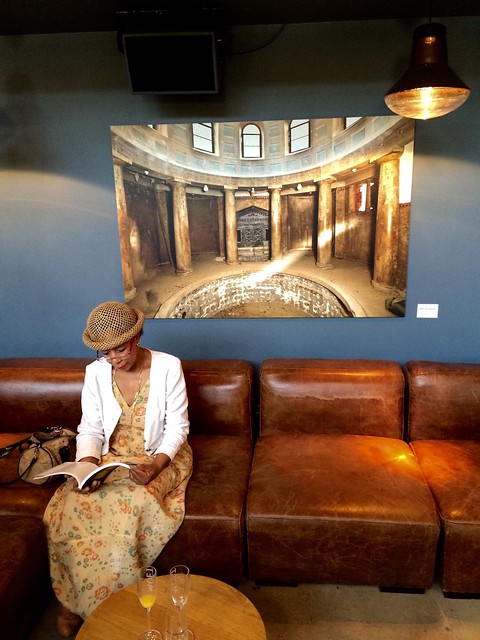
A middle-aged woman sits on a sofa, flipping through a book. A large photograph of a decaying indoor pool hangs behind her. It is a simple picture, but I cannot take my eyes off it. Why?
The photograph was taken during the launch event of Sabine Arndt’s new book, ‘Das Alte Hallenbad Heidelberg. Ein Tempel des Volkes’ at the Frauenbad. The Frauenbad, a public swimming pool for women until 1981, is now a party arena with a bar and a dance floor. We stood there on a Sunday afternoon in May, listening to speeches in German describing the building’s history and the making of the book. Later the crowd milled around the hall looking at the exhibition of Sabine’s photographs. Many stood drinking and talking. A few sat on sofas lining the walls. I was on my way out when I noticed this woman.
We know these moments. A real world scene jumps out as a photograph. It demands to be framed. Would the iPhone capture what I saw?
It did. The photograph works, although I’m not sure why. Colour gives it character and the seated woman appears striking. But there is something else: the inner photograph.
The woman stood out that afternoon among all the Germans, and she seems an odd figure in the photograph too, more a part of the inner photograph than the outer one. The colour of her skin, her dress, her hat, her handbag: they blend into the interiors of the old Frauenbad. There is an understated elegance there, in her dress, the tilt of her head, her leisurely manner of leafing through the book. She belongs to a different time, the era of the Frauenbad bathers perhaps. And I cannot help wondering if the page she is looking at holds the same photograph that hangs behind her.
There are other intriguing symmetries. The woman’s hat and the lamp, similarly shaped and positioned at the diagonal edges of the inner photograph. The large rectangle of the inner photo, the small white rectangle below it to the right, and the (partially obscured) dark rectangle above it. The semi-circle of the table and the semi-circle of the exposed pool in the photograph. The inverted dome of the lamp, and the similar arc we see in the upper portion of the photograph. The shaft of light that angles down towards the woman’s face.
I’m still not certain what makes it work, but I now understand the photograph better.
















